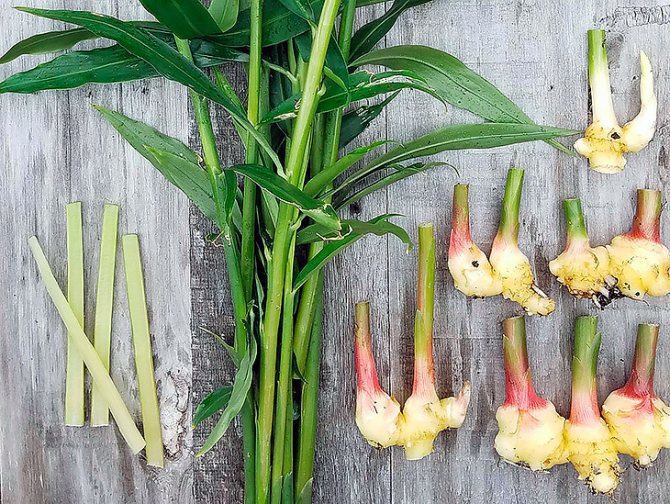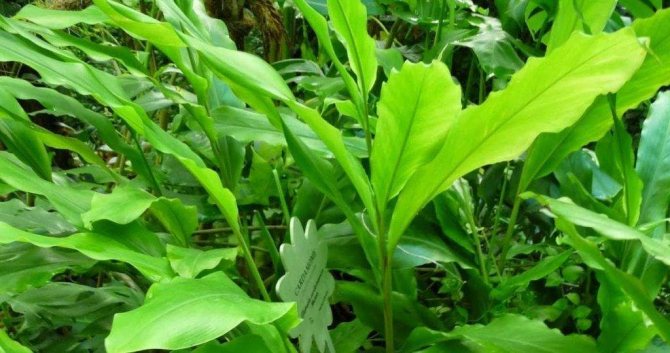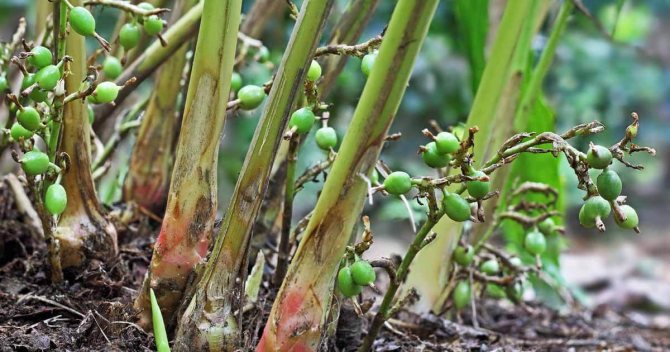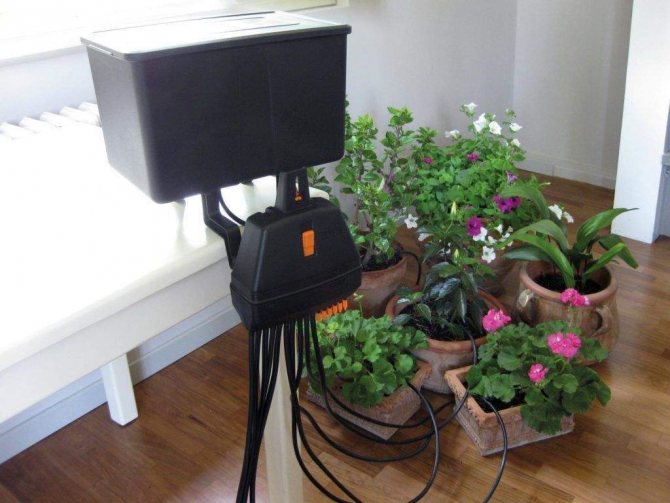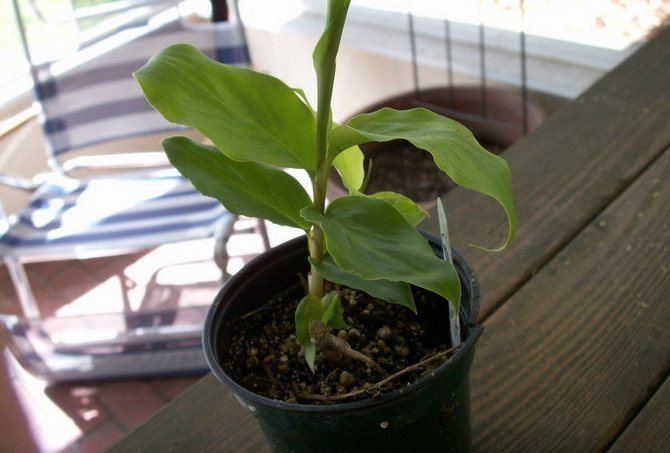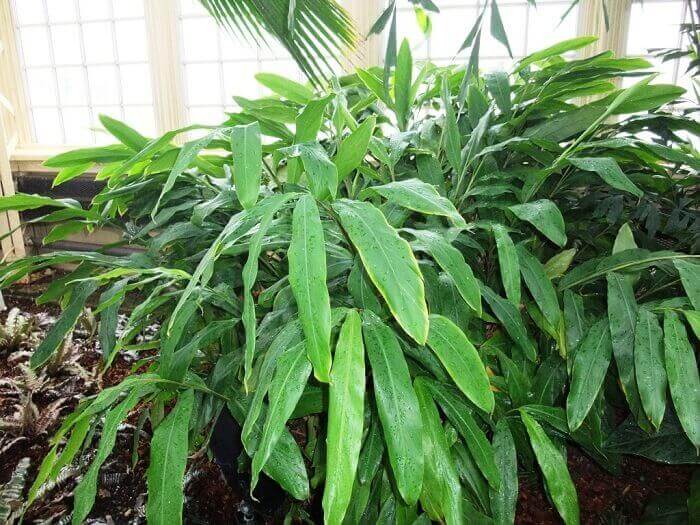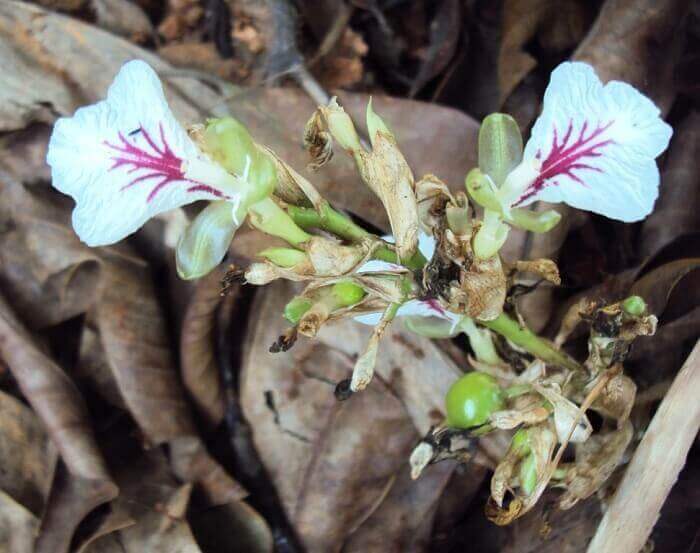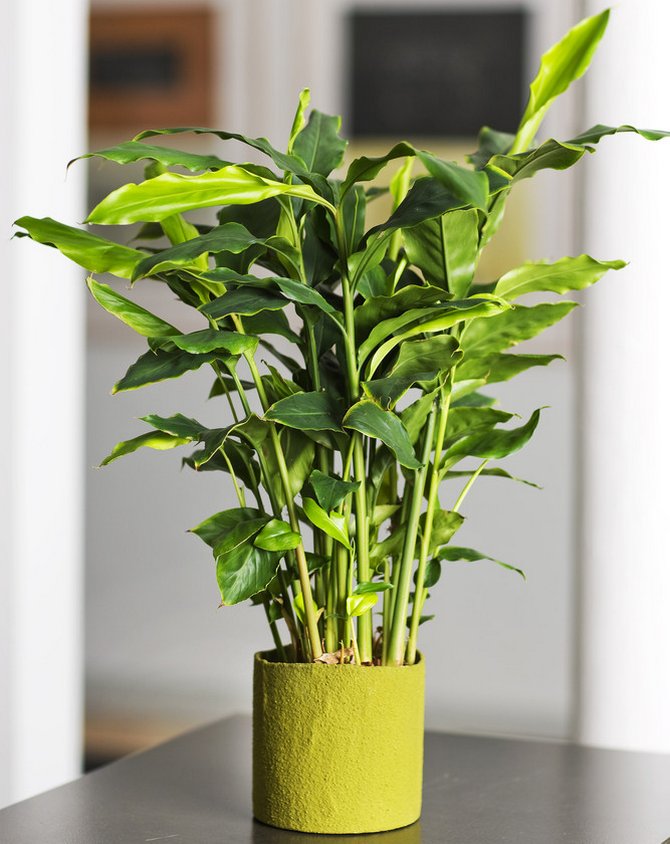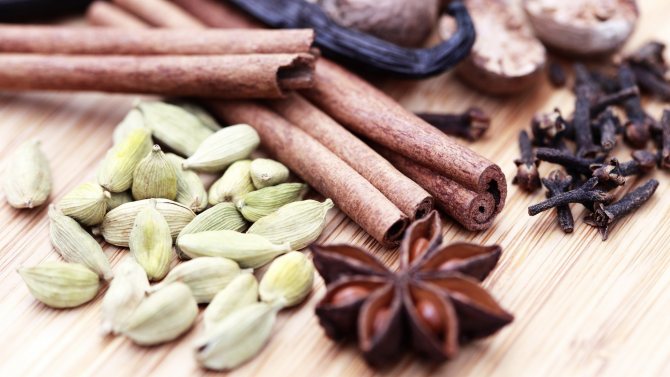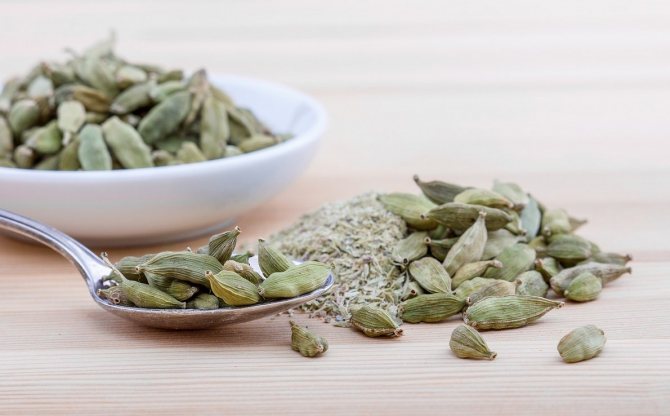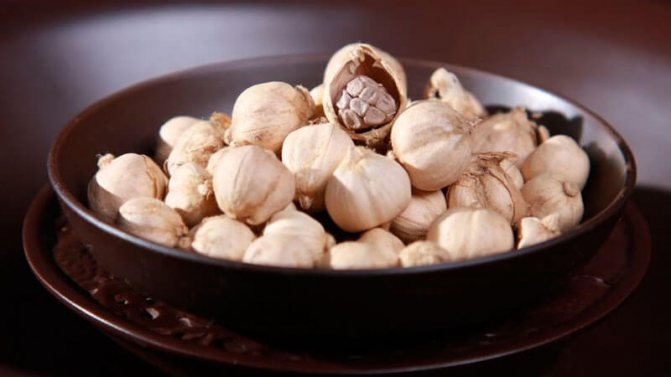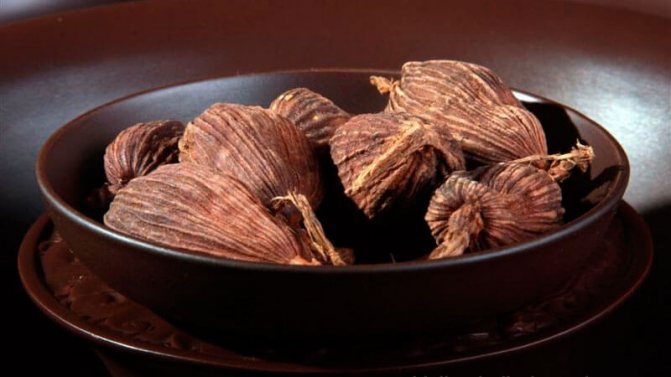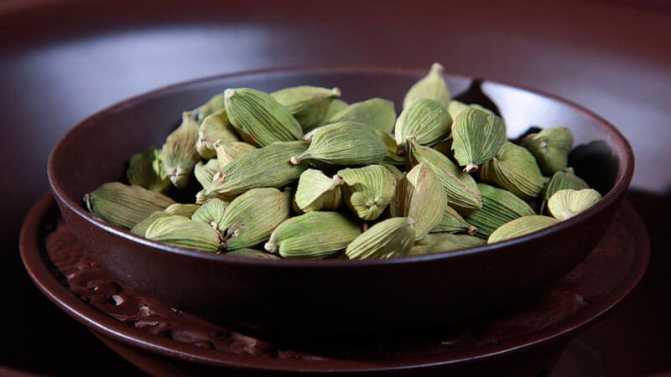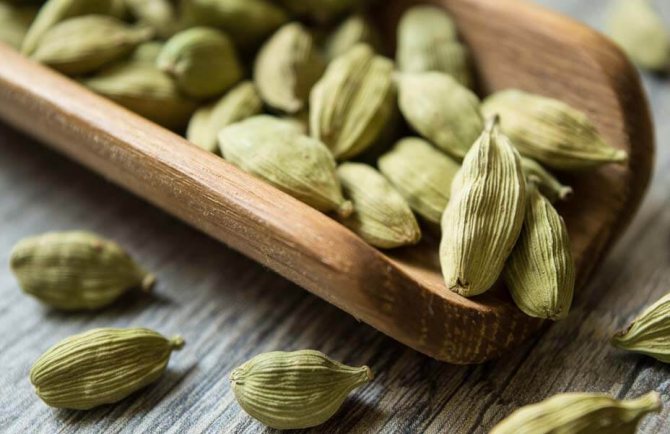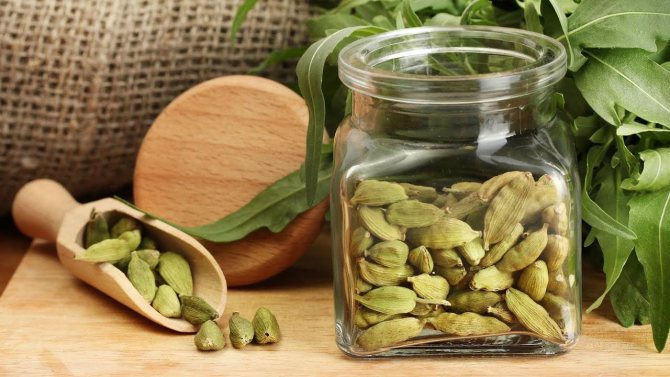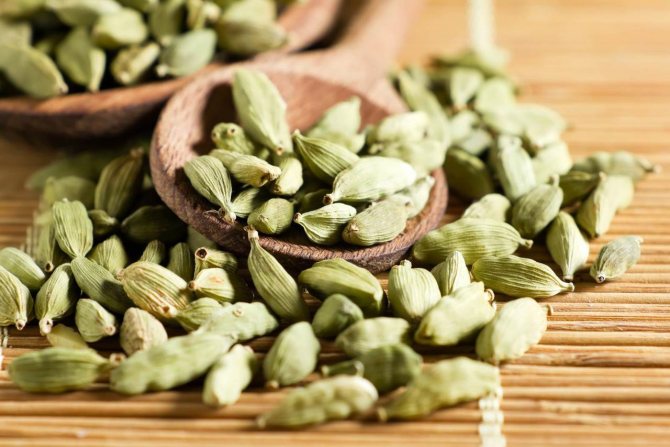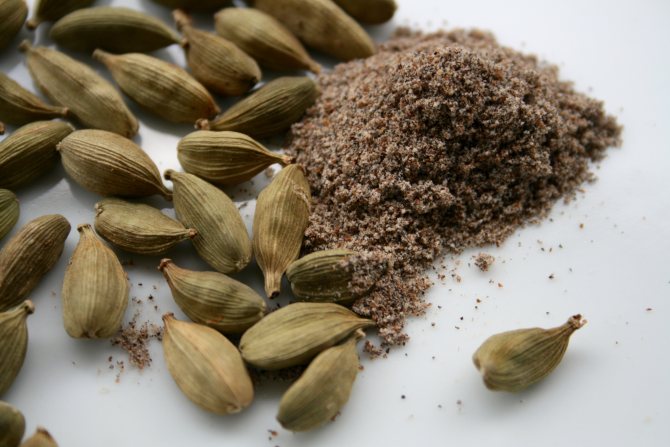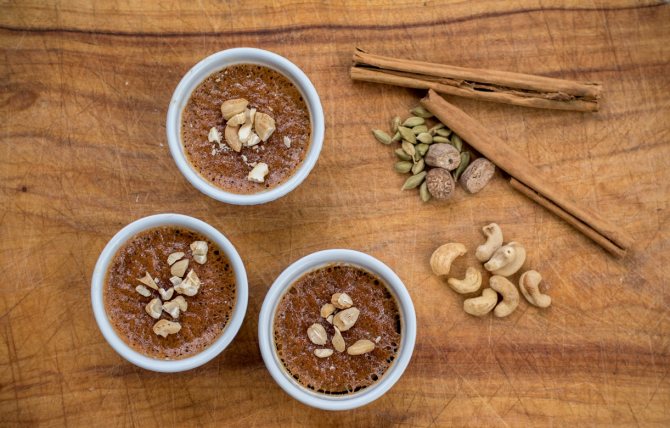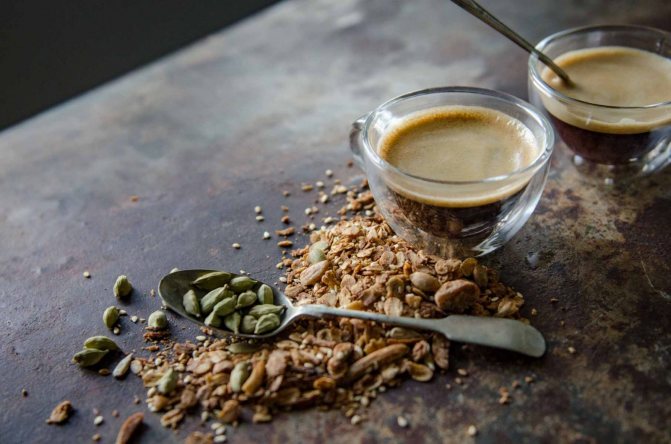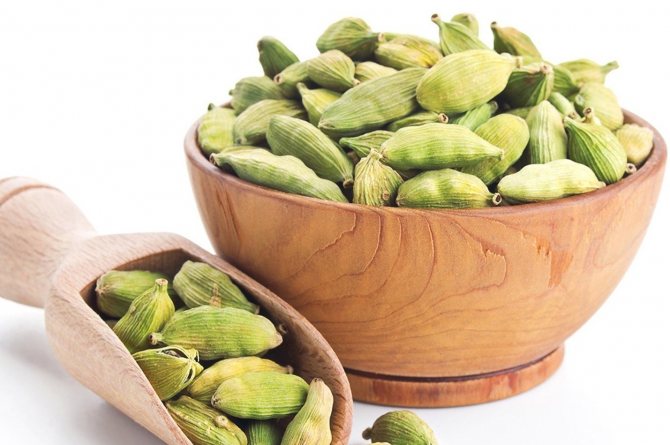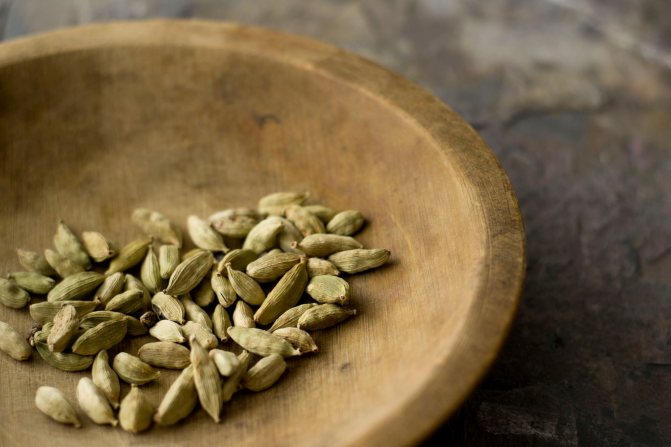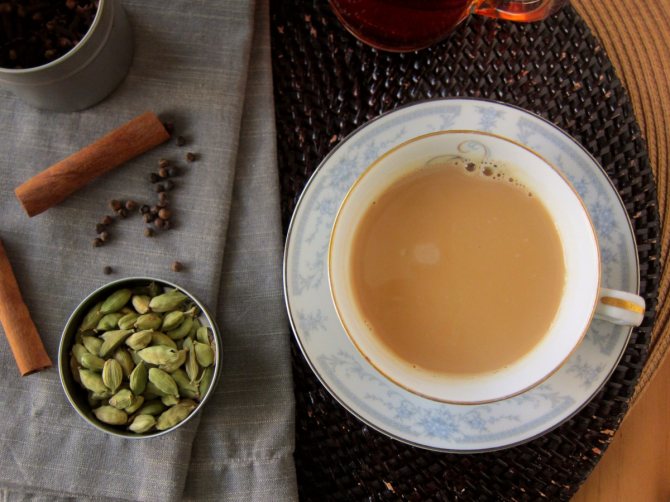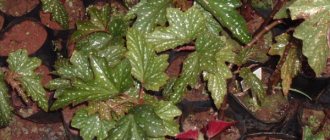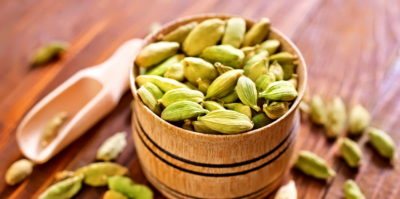
At the mention of cardamom, the image of a distant, overseas spice immediately pops up. The bush of this plant looks very attractive, blooms beautifully.
The article discusses the methods of home cultivation in artificial conditions. The full name of the species is eletaria cardamomum. It is an evergreen plant that has the peculiarity of two stems: a false and a real one.
The first is directed vertically upward, with large dark green leaves on it. The real stem spreads along the ground, leaves on it are completely absent. Flowers appear on this shoot. They are collected in a brush, on which there is one inflorescence with white-purple petals, the rest of the inflorescences are pale green. After flowering, quadrangular capsules with black seeds remain on the stem. This is the spice cardamom.
Reference! Cardamom is one of the most expensive spices in the world, along with saffron and vanilla. The main producer is India, however, the entire crop is consumed domestically and is not exported.
Description of cardamom
Elettaria cardamomum Is an evergreen perennial plant with a fleshy thick root and two types of stems. One of the shoots is false, directed upwards, bears alternate lanceolate dark green leaves, 60 cm long and 8 cm wide. The real second stem is creeping and leafless. In the present, there are flowers matched in a brush. The flowers are small, one petal is white with a purple pattern in the middle, and the rest of the flowers are pale green. After their flowering, fruits appear - boxes of three-nested shape 2 cm long. The seeds are fragrant, black, ribbed.
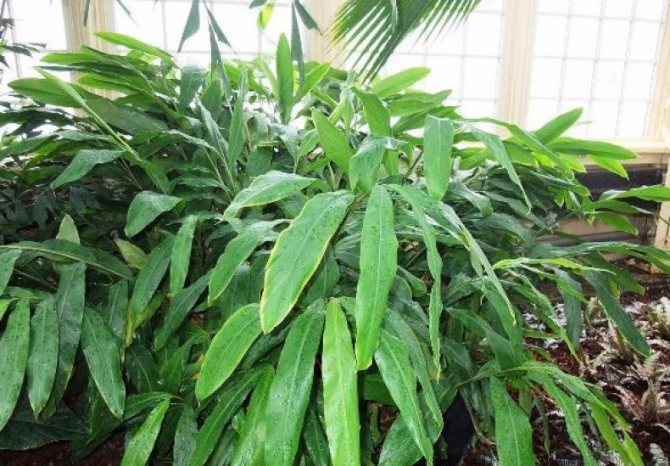

Where to place cardamom
Cardamom is a wildly growing plant that does not exceed a height of one meter at home, with highly elongated dark green leaves. Since it grows almost equally in height and width, it is necessary to allocate an appropriate area and volume for it in the room.
Choosing lighting for cardamom
For the natural course of vital processes, cardamom needs a large amount of bright, but indirect, and diffused sunlight, and in winter the same as in summer. Place it in a home under diffused light or in partial shade.
What temperature and humidity does cardamom need?
Being a heat-loving plant, cardamom feels good in the desired element at a summer temperature of 20-25 ° C, and in winter, during a dormant period, at 12-15 ° C. Cardamom responds responsively to spraying, loves to take a shower or when its leaves are treated with a wet sponge from dust.
How to choose a substrate for planting cardamom
Professional flower growers recommend using a mixture of turf and humus soil and sand for growing cardamom while maintaining the ratio, respectively, 2: 2: 1. But other sources believe that the mixture for these plants should be rich not in humus, but in humus, therefore they recommend buying already made functional mixtures, and the pH must be kept within 5.5-6.
Contraindications
There are contraindications for every product. From acceptance cardamom harm can be applied to people:
- with individual intolerance;
- pregnant women. Of course, it is impossible to completely exclude spices, but taken in limited quantities, they will not harm the health of the baby and mom;
- breastfeeding;
- allergy-prone;
- with gallbladder disease;
- with high acidity;
- with a disease of the gastric mucosa;
- with gastritis;
- peptic ulcer.
A measure is required in everything, even a healthy person can get diarrhea. In the future, this threatens dehydration of the body. You can add a quarter teaspoon of adult powder once.
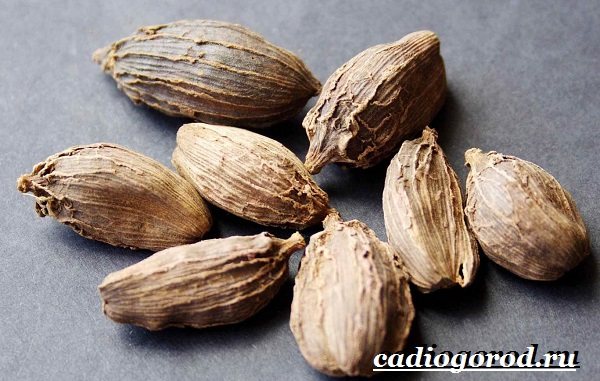

The spice should ennoble the cooked dish with its delicate aroma, and not interrupt it. It is undesirable for small children under 2 years old to eat dishes with spices. When using cardamom oil, the dosage should also be followed as it is considered toxic.
Reproduction of cardamom: how to plant at home
Cardamom (another name for eletaria) has the ability to multiply in three ways: by seeds, by separating rhizomes and by rooting with cut apical cuttings.
Rhizome division
The rhizome of cardamom for reproduction is divided during transplantation, cutting it with a knife in such a way that at least two buds and two growing root segments are present on each separated part of the root. The resulting sections on the roots must be treated with crushed activated carbon (Carbo activatus) and immediately placed in the previously prepared substrate.
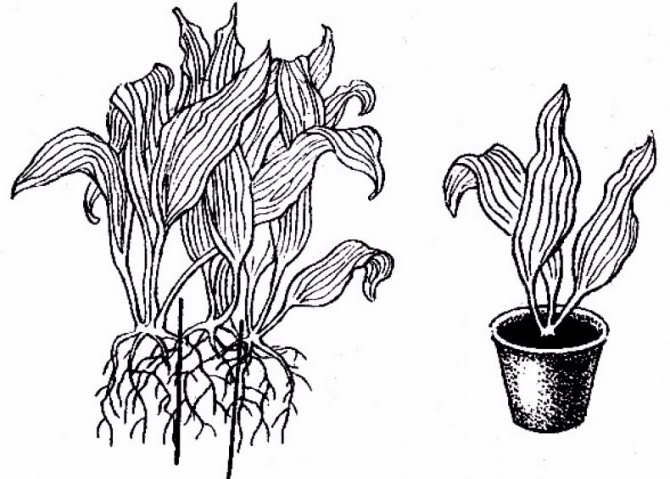

Sowing cardamom
Many people are wondering how you can grow cardamom from seeds? When sowing cardamom, it is necessary to lower the seeds into the soil to a depth of double the width of the seed, after which it should be sprinkled with earth, lightly watered and covered with glass or film. The landing site should be kept at 25-28 ° C and well lit. Since cardamom seeds quickly lose their germination, only freshly harvested seeds should be planted. The expected shoots should appear in 6-7 weeks. After that, we continue to monitor the humidity and temperature.
The first feeding can be done in two months, since there are still enough useful substances in the soil. Closer to late autumn, lower the temperature of the content and reduce watering, the leaves will turn yellow, and growth will slow down. In the spring, cardamom is brought out of hibernation, which, as you can see, is not particularly difficult to grow from seeds at home.
Cutting cardamom
When grafting, the apical cuttings of cardamom, after cutting and processing the cut with a solution of a root growth accelerator, are placed in water. When the roots are formed, they are transferred into a prepared container with a substrate, watering begins, sprayed - and then the usual care follows. According to other sources, the apical cuttings of cardamom root well at 20-25 ° C also in wet sand, and after the formation of the roots, they are transplanted into a permanent pot and undergo normal maintenance.
Features of caring for cardamom at home
When caring for a cardamom plant, you need to pay attention to its leaves, constantly removing those of them that begin to fade or turn yellow. In case the pot it is in becomes cramped, be sure to transplant cardamom. When grown under artificial conditions, you are unlikely to harvest from it. However, cardamom leaves also contain essential oils and are perfectly acceptable to use as a source of aroma.
How to water a plant
In the summer, during the active period of its life cycle, cardamom requires regular watering, the result of which should be a constant and even moisture of the ground cover. In principle, no water retention in the root system of the ginger plant is allowed. In winter, during the passive period of the plant's life, watering is reduced, but care must be taken that the soil does not dry out.
Insufficient watering can lead to drying out and the acquisition of brown leaves, in this case, watering is gradually increased, observing the plant. If the leaves of the cardamom begin to turn yellow, then this is a consequence of bright sunlight that needs to be shaded.
Top dressing cardamom
In a dynamic spring-summer life period, in order to increase soil fertility and enhance microbiological activity in it, it is recommended to feed it every two weeks with organo-mineral fertilizers for vegetable crops. In winter, the time between feedings is up to three weeks.
Read also: Successful land Vladimir region official
With an excess of fertilizers, especially those containing nitrogen, the condition of the cardamom worsens. The use of "Ferovit" and "Zircon" once every two weeks in the composition of the sprayed solution will increase the resistance of cardamom to dryness during the heating season.
When a cardamom transplant is needed
Cardamom has a specific feature to grow very quickly, this is especially inherent in its fleshy root, therefore, transplantation in order to separate the newly regrown roots is carried out annually.
What to replace in the recipe
What is a substitute for cardamom if you cannot buy it because of the high price? While it has its own totally unique flavor, there are other spices you can use as a substitute.
Mix equal parts cinnamon and nutmeg and use in place of the same amount of cardamom as required in your recipe.
Try 1 part each cinnamon and ginger, or cinnamon and ground cloves.
So you've learned what cardamom is, how to use it and why it has been renowned for its culinary and medicinal properties for centuries.
Features of flower pruning
The basic rules for pruning plants include:
- To pull the trunk up, the side shoots are removed completely.
- Cutting off the shoot leaving two or three buds on it will cause the cardamom to bush.
- Unsymmetrical branches and those that go beyond the bounds of a given shape must be cut off.
- Shoots directed inside the crown and interfering with each other are cut off.
- Pinching the top usually leads to uniform growth of the shoots.
- Observe the direction of growth of the buds in formative pruning.
- When shoots grow to the desired level, they are pinched (by removing the top above the last leaf).
- Pruning should be done annually at the beginning of the growing season.
- Top dressing, including by spraying, after pruning will help the plant to expel new shoots.
Diseases and pests of cardamom
When keeping cardamom in a room with a small amount of moisture, eletaria can be attacked by a spider mite or scale insect. To combat the spider mite, you can use insecticidal agents "Vermittek", "Fitoverm", "Aktofit", etc., several times at intervals of two weeks. Repeated spraying with drugs is caused by the fact that they will not affect the eggs of the pest.
When fighting the scabbard, first of all, you need to isolate the plant, remove the insects with a cotton swab, rinse it with soapy water or tobacco infusion, rinse the solution and let it dry, then sprinkle the cardamom with an insecticide solution, cover with polyethylene for 30 minutes and rinse off the drug after two days. This procedure must be repeated weekly until the insects are completely destroyed.
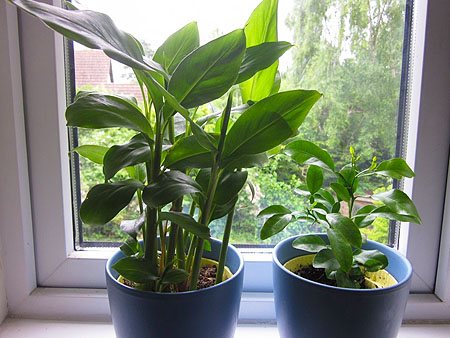

Exotic plants have long been grown at home. After all, they not only create comfort in the apartment, but also have useful properties. Cardamom is called the king of spices; this spice is one of the most expensive in the world. The plant belongs to the ginger family. Its leaves and fruits have a pronounced camphor aroma with hints of mint and citrus.
An evergreen bush can be grown at home on a windowsill, but it will take a lot of effort. But the fragrant bush will delight the eye, in addition, you can count on the harvest.
A hot-sweet spice is added to hot and sweet dishes, or to tea or coffee.
Views
In the literature, you can find a large number of descriptions of Cardamom species, often very contradictory, note that "real Cardamom" or "Cardamom green" has only two subspecies: this is Elettaria cardamomum Maton var. minuscula Burchill known as Malabar, cultivated in the Malabar Coast region, India and Elettaria cardamomum Maton var. major Thwaites or Ceylon, successfully cultivated on the island of Sri Lanka.
Cardamom CeylonCardamom Malabar
The sizes of the Malabar fruits are much smaller than the Ceylon ones, but they significantly surpass the latter in their gastronomic qualities, they are distinguished by a pungent, pungent taste, a delicate aroma with a camphor tone and a lemon tint. This is the most popular, expensive and demanded type of Cardamom.
Along with the species listed above, there are other plants, the fruits of which are very similar in both taste and aroma. The most common of these is black Cardamom, genus Amonum, (Amomum Cardamomum L) also belonging to the Ginger family. The growing area of this genus is quite wide - Asia, Australia, China and Africa. One of the popular subspecies of Amonum, White Cardamom (Pinyin or dou-kou) or Siamese, is widespread in China. Outwardly, it is not much different from its green counterpart, but inferior in taste. Its seeds have ginger and camphor notes, a strong menthol presence and a floral aroma, and it is not very pungent. This type of ginger is widespread throughout Southeast Asia.
Cardamom varieties for growing on the windowsill
It is possible to grow a bush at home, but the appearance will be slightly different from a fellow that grew in natural conditions. The most popular varieties of cardamom are:
| Variety | Feature |
| Green | The fruits ripen in green boxes with brown grains inside. One of the most common varieties. In cooking, it is added to the dough. |
| The black | The plant bears fruit in the form of black grains. Their aroma is similar to that of haze, and they taste pungent. The plant is highly valued both as a spice and for its medicinal properties. |
| Ethiopian | This variety is analogous to black cardamom. The fruit has a pronounced spicy aroma, but the spice is of a lower quality. |
| White | Suitable for food use. The spice has a mild taste and lack of characteristic pungency. |
The most commonly used are black and green cardamom. The black variety has more than 179 subspecies, and the green variety has 11 varieties. Despite the fact that evergreen bushes do not grow in Russia, you can buy seed at a flower shop.
The main characteristics of the plant


Cardamom is an evergreen perennial. It belongs to the Ginger family, as it has a fleshy root system. In its natural environment, the flower grows in Sri Lanka, India, Tanzania and Madagascar. Despite its tropical origins and where cardamom grows in nature, it has been successfully cultivated on a windowsill.
The peculiarity of the plant is fleshy roots and two types of stems. One of them is called false. It rapidly reaches to the top and foliage grows on it. Another escape is considered real. There are no leaf plates on it, but during the flowering period, buds appear, collected in dense brushes.
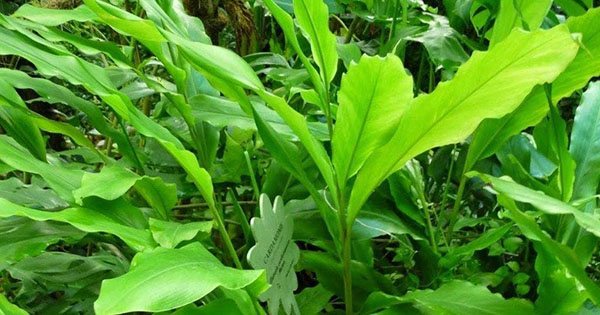

When the flowering period ends, fruits appear in the form of small bolls.
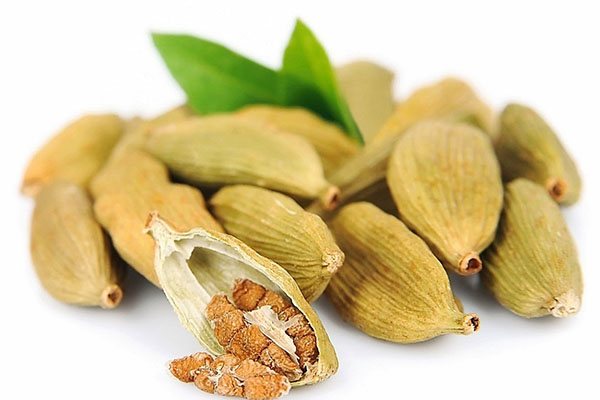

Each of them contains many seeds that are used for plant propagation and as a spice in cooking.
When choosing a permanent place for a plant in the house, you should take into account the amount of diffused light. At the same time, the flower does not like direct sunlight. In critical situations, it is necessary to create an artificial shadow over the plant.
What you need to grow cardamom
Growing exotic plants at home is a painstaking job.Indeed, in natural conditions, they are accustomed to a warm climate and high humidity. In any case, before you can plant cardamom at home, you need to buy the necessary ingredients.
- Seeds, roots, or cuttings of a perennial;
- Spacious container;
- Nutrient substrate;
- Drainage filler;
- Fertilizers for indoor flowers.
Once all the inventory is prepared, you can start planting. A little patience and love in the process will not be superfluous.
Choosing the best place in the house
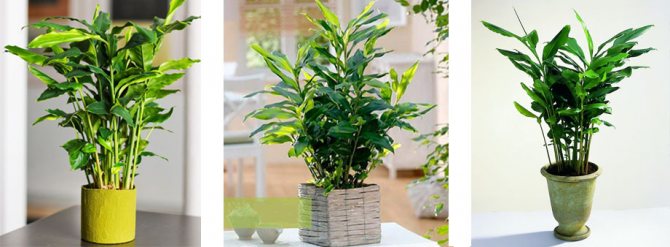

Do not place containers with cardamom near heating appliances. The leaves dry out from the hot air, and the soil dries up.
Selection and preparation of containers
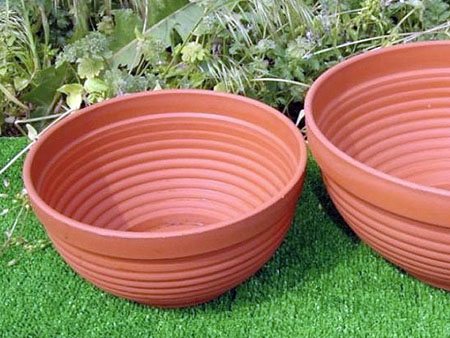

You can grow cardamom at home in a spacious container. The roots of this small tree are massive and strong, so the container should be low but wide. These can be both clay pots and ceramic flowerpots.
- Since the plant loves watering, wooden containers should not be chosen because of their low moisture resistance.
Before planting, pots or flowerpots are thoroughly rinsed with running water. Remnants of old soil or debris are washed away. If the container is new, then it should not have a specific smell. Then wide holes are made at the bottom to drain the water. Pallets are placed under the pots.
Soil selection
High-quality fertile substrate - 50% success when growing a cardamom plant at home. A miniature tree prefers loose soil with good moisture and air permeability. Ready-made primer can be bought at a flower shop. Suitable for a universal substrate, or special for ornamental plants.
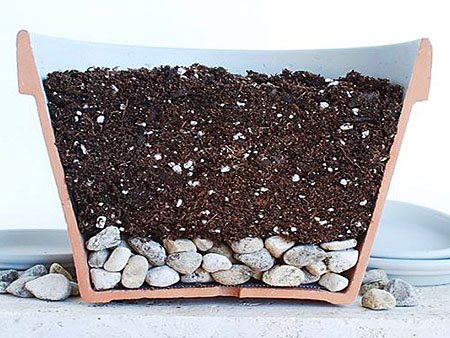

You should not tamp the soil in the pot too much: it should be loose and allow oxygen to pass through well.
It is possible to prepare the soil on your own from a mixture of turf soil, humus and sand (2: 2: 1). The humus-rich soil is also good for cardamom. Ideal pH: 5-6. The bottom layer is covered with drainage filler.
Creation of the necessary conditions: lighting, air humidity, temperature
How to choose and where to buy
Both the seeds and ground cardamom are sold in the spice section of supermarkets, while the whole pods are available in specialty stores.
When shopping for cardamom, choose green as it has a complex flavor that suits both sweet and savory dishes.
It is better to choose whole pods, or rather cardamom boxes, than ground spice. The greener they are, the better the flavor.
Cardamom is an expensive condiment, but most of the cost comes from long distance shipping and intermediary services. If you do not want to overpay, buy it from the international online store IHerb.
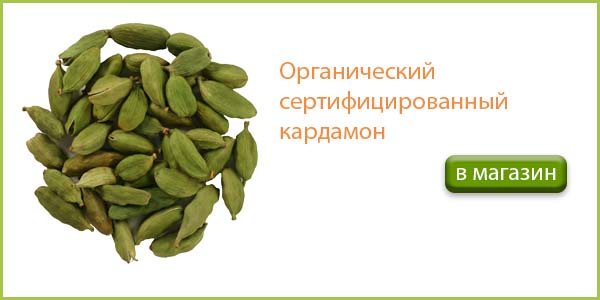

Growing from seeds
The main feature of growing cardamom on a windowsill from seeds is the freshness of the seed. Fragrant grains quickly lose their germination, so freshly harvested seeds are planted in containers with peat and sand at a temperature of + 25 ° C. It is not required to soak and germinate the seeds before planting.
Seed preparation for planting:
- Fresh grains are placed in a weak solution of potassium permanganate. The procedure is optional, it is used for disinfection purposes;
- Drainage is laid out at the bottom of the pot, soil is poured on top;
- 2 seeds are planted in one container to a depth of at least two centimeters;
- Sprinkle with a thin layer of earth, cover with a film, or a glass jar;
- In greenhouse conditions, the grains are moistened and periodically ventilated.
The first shoots appear in 1-2 months.
After the first shoots, the sprouts do not need additional shelter. It is enough to provide moisture and warmth.


Tincture recipe
Cardamom tincture is an aromatic drink. It is easy to prepare it. This requires the following ingredients:
- half a liter of vodka;
- spice pods;
- a glass of sugar;
- half a liter of water.
Seasoning is placed in a sterilized two-liter jar, vodka is poured, covered with a lid and placed in a dark place for fourteen days. Then sugar is dissolved in hot boiled water, cooled and poured into two bottles. After that, through a funnel with gauze, add vodka infused with cardamom, shake thoroughly, seal the containers and leave in a cool place for two days.
Growing by dividing rhizomes
Propagating cardamom by dividing the roots is the fastest and easiest way. However, for this you have to wait until the plant gets stronger. This usually takes 6-12 months from the first shoots. The rhizome is carefully cut with a knife so that each part has at least a couple of buds and growing roots. The separated roots with shoots are planted in moist nutrient soil, after which they are cared for.
Read also: Istra Riviera cottage settlement Kaluga region
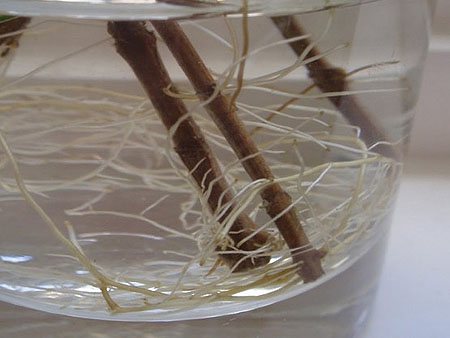

Weightloss remedy
An effective remedy for excess weight is cardamom tea. It helps cleanse the body, normalizes metabolism. To prepare the product you will need:
- a teaspoon of cardamom fruit;
- glass of water.


The fruits of the plant are poured with boiling water, infused for twenty minutes, and then filtered. The funds are enough for three or four doses. It is consumed before meals for fourteen days. During the intake, it is advisable to adhere to a diet.
Growing by cuttings
Cutting cuttings is permissible only from an adult plant. Ideal length of shoots: 7-10 cm. To do this, cut off the apical shoots of cardamom and put in a jar of water or wet sand. In order for the cuttings to take root faster, the cut sites are treated with a growth accelerator solution.
After the roots appear, the standard potting procedure follows.
The cuts on the rhizomes are treated with crushed activated carbon so that they do not rot.
How the seasoning is obtained
When the fruit of the cardamom is fully ripe, it opens and the seeds fall to the ground or are blown away by the wind. Therefore, the pods are harvested while they are in a slightly immature state, and the seeds inside them are just starting to darken. Then the pods are dried in the sun.
Sold in whole, broken or crushed pods, only seeds and in a ground (powder) form.


Plant care: watering, feeding and pruning
Since cardamom is native to warm countries, it loves watering abundantly. However, the excess moisture at the roots is more critical for the plant than the drying out of the earthy coma. Water the tropical tree abundantly, avoiding stagnant water. In the summer, watering is needed every day. In winter, it will be enough to moisten the soil once every one and a half to two weeks.
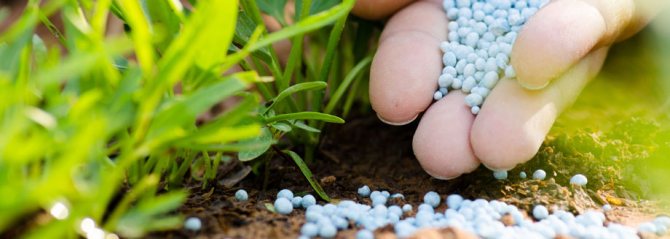

As for feeding, during the period of active growth of seedlings, the soil is fertilized for the first time after 2 months. This is due to the fact that the sprouts absorb the maximum of nutrients from the soil. Then the top dressing is applied only to stimulate growth in spring and summer. Fertilizers with a mineral-organic composition are ideal.
Cardamom usually blooms in the third year. The flowers are elongated from pale pink to purple in color. Forming a lush crown of a tree will not work without pruning. The procedure is carried out in the stage of active growth in the spring.
How to prune a plant correctly:
- Dense branches that interfere with the normal growth of each other are removed;
- The side trunks are cut so that the main false one actively grows up;
- A new bush will form if at least a couple of buds remain on the cut shoot.
Cardamom leaves are natural air fresheners.
So that the shoots grow evenly, and the crown is lush, pinch the green tops.
History
The history of the cultivation, distribution and use of cardamom in various industries dates back to the I-II millennium BC.
This plant was first discovered in India and was used by local people for medicinal and nutritional purposes.After the discovery of India and the beginning of international trade, Arab merchants began to actively supply spices, including cardamom, to the world market.
This spice was so appreciated by buyers that the place of origin of cardamom was carefully hidden.
The Arabs used this plant for medicinal purposes, creating prototypes of modern medicines - elixirs, mixtures, syrups.
By the 12th century, the popularity of cardamom had spread to European countries. From that moment, the use of this seasoning began to flourish in food, medical fields, as well as in perfumery and aromatherapy.
Diseases and pests
Cardamom is susceptible to viral infections among the flora. In addition, excess moisture can trigger fungal infections.
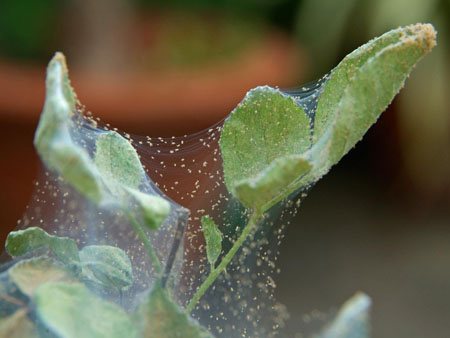

The main pests are scale insects and spider mites. You can destroy the shield by treating the leaves with a soapy solution. Then the concentrate is washed off so that the solution does not get into the roots. They fight spider mites with insecticides. The preparations "Fitoverm" and "Aktofit" are used in several stages, since they do not act on the eggs of parasites.
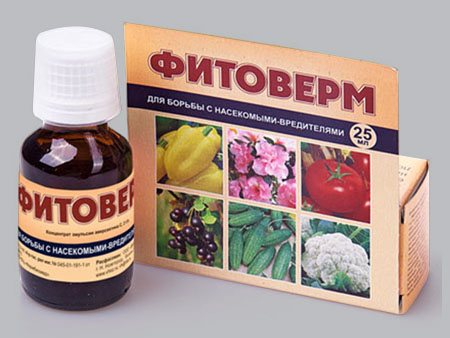

The main reason for the appearance of pests at home is a lack of moisture and dry air. Insects are not repelled by the essential oils in the leaves. Small parasites settle on the shoots and the inner side of the leaf and suck the juice out of the plant.
What is included
The plant is rich in:
- Phosphorus.
- Magnesium.
- Calcium.
- Water-soluble vitamins (B1-B3).
- Manganese.
- Essential oils (8%).
- Terpenoids.
- Potassium.
- Flavonoids.
- Iron.
- Carbohydrates.
- Sodium.
- Proteins.
There are no fat-soluble vitamins in the spice.


Harvesting and storage
Cardamom fruit resembles boll-shaped bean pods. Inside there are green or light yellow grains of a round shape. The seeds are no more than 4 millimeters in diameter and have a spicy-sweet aroma. The appearance of the first harvest falls on 3-4 years of cultivation of a tropical inhabitant.
The active flowering period is from January to March, so the grains are harvested from October to December. Even in one inflorescence, spicy fruits ripen unevenly. This makes harvesting much more difficult.


- At home, cardamom seeds are harvested shortly before their maturity, otherwise they fall out of the capsules;
- Usually closed pods are dried in a well-ventilated area or in an oven;
- The grains are ground, but in this case they quickly lose their aroma and some of the essential oils;
- It is best to use fragrant seeds from whole pods;
- The spice is stored in tightly closed containers at a maximum room temperature of +25 degrees.
Spice is added both to the first and second courses, and to drinks. So, milk with ground cardamom soothes the nervous system, gives strength.
Growing cardamom at home is easy with moderate humidity, ambient light, and regular pruning. The bush stretches up to 90 centimeters in height, and pleases the eye with a lush crown. The beautiful decorative appearance of the plant pleases the eye all year round, and the essential oils in the leaves fill the room with a spicy scent.
Indoor cardamom is called nothing less than the main competitor of indoor bamboos. This non-standard plant is distinguished by its special beauty of greenery and a completely inimitable character. Modern, daring, bright, it deserves much more popularity and a completely different status. Moreover, it is not difficult to grow cardamom, and only laurel can be more aromatic. Its belonging to rare exotics is all the more surprising because the plant is completely inexpensive, grows quickly and is unpretentious in care.


Real cardamom, or Elettaria cardamomum. <>
FAQ
Comrades, many people know the tropical culture only from the store shelves with spices, so there are a lot of questions related to its growth, breeding and use.
Contraindications for the use of cardamom
Cardamom is beneficial when consumed wisely. Too much spice leads to stomach pains.
You can not eat the product when:
- allergies;
- individual intolerance;
- gastritis;
- gastric ulcer;
- hypertension.
Cardamom is contraindicated in pregnant women and persons suffering from chronic gastric, intestinal, liver diseases.
How is cardamom used in cooking?
The fruits of the plant are added to drinks, main dishes. They are combined with:
- pepper;
- zira;
- cinnamon sticks.
When preparing food, I add the seasoning immediately, because the opening of the aroma takes time. I remove the seeds after cooking.
Author's note
Natalia Papanova
Blog author
In sweets, fermented milk comes fresh ground cardamom. For salads, plant greens are ideal. I include seeds in marinades for vegetables, fish, use in cheeses, canned food.
Cardamom is a traditional ingredient in German gingerbread and Scandinavian sausages. In Russia, they cook Easter cakes with him.
Adding cardamom to alcohol eliminates the characteristic unpleasant odor and enriches the taste.
The video tells about how useful drinks with cardamom are:
Real cardamom and its legendary scent
The plant that all lovers of custom houseplants and medicinal potted plants know as true cardamom actually belongs to the genus Elettaria. Amazing herbaceous perennials from among the Ginger (Zingibiraceae) are represented in nature by several dozen plants. But the only species is considered as decorative - the same cardamom real, or elettaria cardamomum (Elettaria cardamomum).
An evergreen perennial from among medicinal and spicy plants became famous for the beauty of stems and leaves. The rhizome of the elettaria cardamomum is fleshy. The height of indoor cardamom is limited to 40-60 cm, but the plant does not seem miniature at all. Bushy, powerful, developing in the form of a turf from numerous vertical shoots, it really reminds of genuine bamboos with its silhouettes.
They look like stems, false shoots, stretching up and covered with leaves, while real shoots remain almost invisible: leafless and creeping, they are hidden from prying eyes and are visible only up close. But it is the real second stem of the cardamom, not the false shoots, that produces the flowers.
Leaves are remarkably in harmony with the shoots - pointed, large, lanceolate-narrow. They are initially rolled up into a tube and unfold in an interesting way, opening to their full length. Cardamom leaves sit on rather long graceful cuttings alternately, in length they can reach 60 cm with a maximum width of 8 cm.The rich dark green color is very attractive. But the main thing in the leaves is not at all their beauty.
This is a unique houseplant whose leaves are not only fragrant, but also curative. They can be used as an alternative to tea and brewed in drinks or herbal infusions. Subtle and surprisingly exotic undertones of cinnamon and cardamom smells fascinate and invigorate. You can only appreciate the tart-spicy charm of cardamom by rubbing the leaves between your fingers.
However, cardamom became famous for the scent not of leaves, but of fruits. The flowering of the plant is an extremely unusual sight. The flowers of elettaria cardamomum appear on a creeping shoot and are collected in a brush. They would be inconspicuous, if not for one eye-catching petal of snow-white color with bright purple veins, so strikingly contrasting with light green and small petals.
After flowering, in place of the cardamom ovary, original three-nested fruit pods up to 2 cm long develop, hiding the very richly fragrant, ribbed black seeds, which have become one of the most popular spices in the world. The flowering of cardamom cannot be called spectacular, but due to the unusual arrangement of flowers - under the main above-ground parts at the base of the sod from false shoots - and unusual fruits, it is more than original.
Read also: How to make zucchini jam with orange
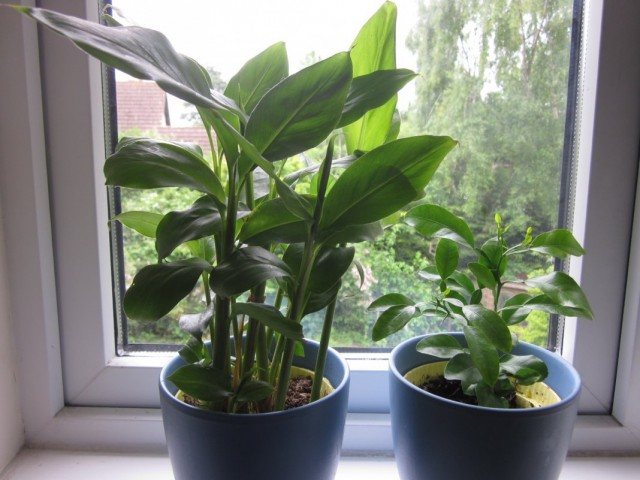

Real cardamom, or Elettaria cardamomum. <>
Using
"Real Cardamom" of the Ginger family, like its relatives of the Amonum genus, along with high decorative qualities, has unique healing properties, is widely used in cooking, in national cuisine recipes in many countries.
Cardamom has been known as a seasoning and remedy long before the birth of Christ. One of the first mentions of this amazing plant was found in the ancient book "Suturta" in India, in the 9th century BC. Even then, Cardamom found application in medicine and cooking. In one of the seven wonders of the world - the Hanging Gardens of Babylon, built by order of King Nebuchadnezzar for his beloved wife Amitis in the 604-562 century BC, this flower was used not only as an ornamental plant, but also as a source of fragrance and an aphrodisiac capable of causing sexual desires and proximity to the opposite sex. This amazing herb is able to significantly reduce the premenstrual syndrome in women and increase the potency of men. In accordance with the principles of Ayurveda, Cardamom is able to balance the three doshas in a person, physiological, emotional and mental abilities, awakening the activity of the brain, clarity of mind, stimulating the work of internal organs, suppressing aggression, causing a feeling of lightness, peace, well-being.
Doshas are three principles of controlling the human body: Pitta (fire), Vata (air), Kapha (water) according to Vedic science.
Home care for cardamom
Indoor cardamom is rightfully considered an unpretentious plant. Cool wintering is not necessary for him, but only desirable. Cardamom will not bother even inexperienced growers, and for those who have an unstable work schedule or like to travel, it will become a godsend. It easily tolerates short droughts and missing watering. But the better it is looked after, the more beautiful the cardamom becomes. And if you maintain an even soil moisture, the amazing foliage of the elettaria cardamomum will unfold in full splendor.
Lighting for elettaria
This is one of the most undemanding cultures for lighting, capable of adapting and maintaining decorativeness in radically different conditions. In principle, cardamom can be grown in any light from bright sunny areas to deep shade. But there is one big “but” in such loyalty: it all depends on the conditions to which the plant is accustomed “from childhood”.
If your elettaria was grown as a normal houseplant, and it is used to ambient light, then it should continue to be grown in the same conditions, even during the winter. If cardamom was grown as a shade-loving perennial and at a young age was adapted to less light, it will pleasantly please with shade tolerance in the future. Therefore, when buying a plant, it is imperative to clarify what kind of lighting the cardamom is used to.
Most of the modern varieties that can be found in flower shops are photophilous, accustomed to diffused lighting and protection from direct sunlight.
Comfortable temperature
The ideal mode of keeping cardamom present involves a warm period of active growing season and a cool resting phase. From spring to late autumn, the plant will be content with the usual room temperature, cardamom will be comfortable in any living space. The optimal temperature range is from 20 to 25 degrees. But the wintering of elettaria cardamomum directly affects flowering and fruiting.
If the temperatures are cool, you can harvest your own flavorful seeds. If the plant remains warm, its attractiveness will not suffer, but it will lose its ability to bloom profusely. For wintering cardamom real, conditions from 12 to 15 degrees Celsius are most suitable.
Watering and air humidity
Elettaria can tolerate short-term drought well. This plant reacts worse not to the drying out of the earthy coma, but to its waterlogging. Stagnation of water should not be allowed under any circumstances. The more uniform the soil moisture is, the more attractive this plant will look. Regular watering of the cardamom after the top layer of the substrate has dried during the spring and summer helps stabilize growing conditions.
With the beginning of a decrease in daylight hours and a cold snap, watering is reduced, the substrate is allowed to partially dry out in the middle layer. But it is better not to allow excessive dryness of the soil even when wintering in a cool place.
Like almost all plants of tropical origin, cardamom prefers high humidity. You cannot call vital measures to increase humidity, the plant does not need to be displayed in flower showcases or in special devices-humidifiers. But elettaria responds to spraying with gratitude, the procedures have a positive effect on the attractiveness of its foliage. If you can spray on a daily basis, cardamom will only benefit.
As part of the procedures for caring for elettaria, it is imperative to clean the foliage from dust. It is best to do this with a damp sponge, gently wiping off the greens and shoots. You can also resort to showering, especially if the air temperature exceeds 25 degrees Celsius.
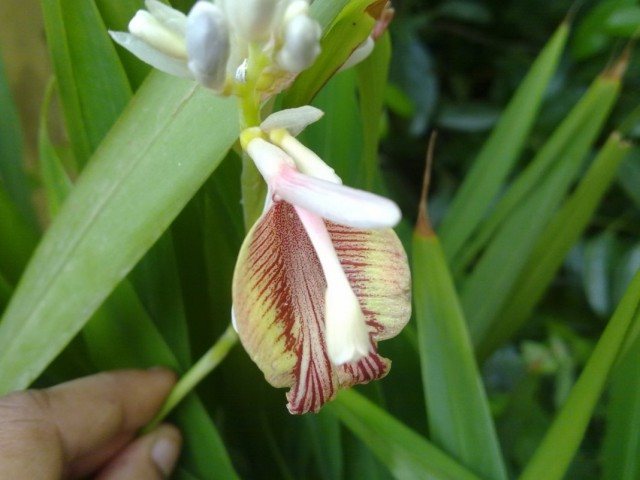

Present cardamom flower
Pruning elettaria
Leaves and shoots of cardamom that have suffered from drying out, injury or lose their attractiveness from old age, it is better to regularly remove, cutting to the base.
Top dressing for cardamom
True cardamom prefers regular, standard feeding. Fertilizers for this plant are applied at a frequency of 1 time in 2 weeks from spring to autumn. For elettaria, it is advisable to use either universal fertilizers or special mixtures for potted vegetables, which will increase the fruitfulness of cardamom.
Cooking applications
This spice is used in a wide variety of culinary fields: it is a versatile seasoning that is used both for meat dishes and sweet pastries. It gives a special piquant taste to biscuits, cakes, honey gingerbread, any yeast dough products, fresh and cooked fruit dishes.
There are many recipes for tonic cardamom teas, and some black coffee lovers find its flavor in combination with ground spice to be exquisite. But such experiments are successful only for those chefs who are already intimately familiar with this spice: it has a spicy and piquant taste, and the wrong proportion can completely ruin a sweet dish.
As for the first and second courses, cardamom perfectly improves the taste of soups and sauces, gives a delicate and mouth-watering aroma to pates, goes well with lamb, beef, pork, poultry and game. In small quantities, they can be used to season homemade sausages and ham.


the spice's ability to produce collagen is used for cosmetic skin care purposes
Transplanting cardamom, containers and substrate
Elettaria is related to bamboos not only in appearance, but also in very fast, aggressive growth. With normal care, the plant fully masters the capacity in a year, therefore, regardless of age, indoor cardamom is transplanted annually.
For elettaria, wide containers are used, in which the depth is less than the diameter. The wider and lower the bowl is, the better. It is advisable to provide the plant with large holes for water drainage.
The substrate for cardamom is selected from a number of simple, universal earth mixes with good water and air permeability. You can use a commercially available substrate (universal or for decorative deciduous plants) or independently compose the soil from humus and soddy soil with sand (ratio 2 to 2 and 1, respectively).
The procedure itself is standard. Elettaria is not afraid of contact with the roots, but if possible, it is better to carry out the transplant procedure as carefully as possible. A high drainage layer is laid at the bottom. The soil is compacted as little as possible. After transplanting, the plant is shaded for several days, if possible, the air humidity is increased.
What are the beneficial properties of cardamom
The plant is rich in B vitamins, ascorbic acid, rutin. It contains trace elements, minerals, proteins, thiamine. It increases the tone of the body, prevents disease. I drink a drink with cardamom to prevent:
- flu;
- colds;
- cough;
- diabetes.
For me, growing rosemary and elettaria in my apartment is not only a way to create an aesthetic corner, but also a source of healthy products.
I use cardamom oil as an antiseptic for sore throat and fungal infections. In case of pulmonary diseases, it helps to improve expectoration.
Water treatments with cardamom oil help you calm down. By adding to food I eliminate heartburn.
Diseases and pests of cardamom
Elettaria cardamomum is considered a resistant houseplant. It can only suffer from specific viral infections (when the plant is bought already infected, systemic fungicides need to fight the problems) and from pests. From insects, subject to dry air, careless care and proximity to infected plants, cardamom is threatened by spider mites and scale insects. You can fight by mechanical washing, correction of conditions, and treatment with insecticides.
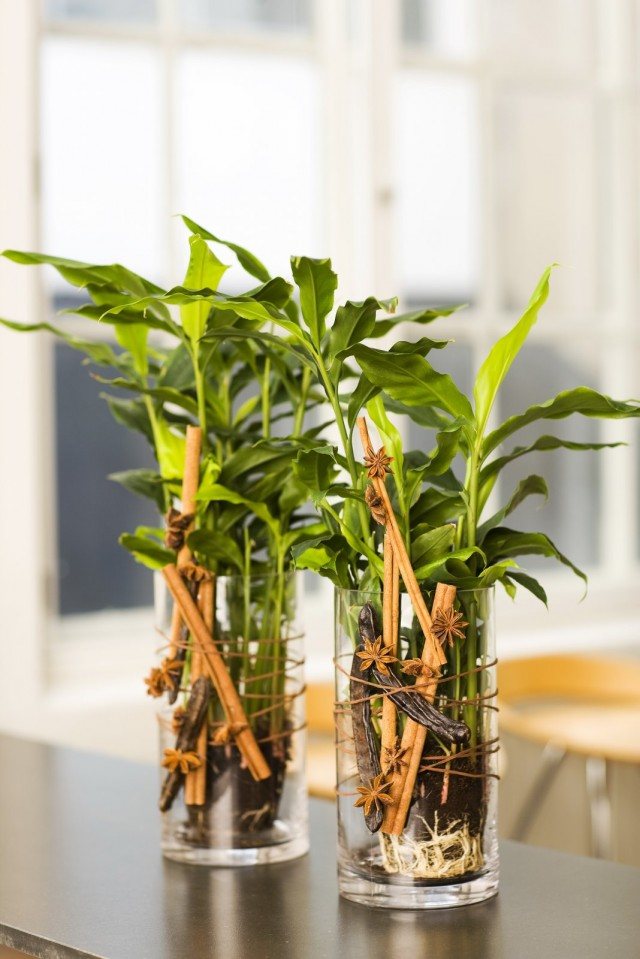

Real cardamom, or Elettaria cardamomum. <>
Reproduction of indoor cardamom
Elettaria can be obtained both from seeds and vegetative methods.
The easiest way is to propagate cardamom by dividing adult plants. During the annual transplant, you can divide the sod into pieces with at least two roots and buds. Slices are necessarily processed, but this is where the complexity is exhausted. Plants are simply planted as independent crops using conventional transplantation technology.
You can get new copies of cardamom and cuttings. The tops of the shoots are easily rooted in the greenhouse at temperatures from 20 to 25 degrees, especially if the sections are treated with a growth stimulant or rooting agent. A standard substrate is used.
Getting cardamom from seeds is a bit tricky. Seeds are sown exactly to a depth equal to their double width, watered only after sowing, and even then creating a slightly moist environment. Seeds are germinated in heat, at a temperature of 25 to 28 degrees, with very bright lighting, under glass or film. Seedlings are fragile, but they quickly become hardy and actively develop. Cardamom dive after the appearance of the second leaf in individual small pots. For young plants, transplants are carried out as needed.
Cardamom: instructions for use
The presented natural component is used to treat a wide variety of diseases, which entails compliance with the established instructions for use... A small list of recipes for the consumption of cardamom in the treatment of diseases should be given:
- If a person is sick, he can simply chew 2-3 spice seeds. Due to its effect on the work of the stomach, it is often recommended to take it with you when traveling by transport.
- If an intestinal disorder is noted, cardamom in the amount of three crushed seeds and a small amount of ginger grated on a grater is brewed with a glass of boiling water. Then the infusion should be boiled for one minute and left to cool slightly. The resulting broth is drunk in the form of ordinary tea. Similarly, you can drink regular tea with cardamom and ginger. The same composition should be consumed for constipation.
- As a prophylaxis for viral diseases, cardamom is used together with honey, mixed in a 1: 1 ratio.
- Slimming cardamom used with green tea and lemon juice. For one cup of brewed natural green tea, there is a quarter teaspoon of ground cardamom and a few drops of fresh lemon juice. Drink a similar mixture every morning - this contributes to normal digestion and accelerates metabolism.
- If you decide to cleanse yourself, it is recommended to pour a teaspoon of ground cardamom with a glass of boiling water and drink the slightly settled strained composition in a few days - the daily dose of the drink is a quarter of one glass.
- For diarrhea, an infusion of spices, fennel seeds and dill is also used. To do this, all components are mixed in equal amounts, and a teaspoon of the resulting collection is poured with a glass of boiling water. The infusion is allowed to cool and taken from one tablespoon, increasing the amount to a quarter of a glass. Take the infusion 2-3 times a day.
- Milk with cardamom consumed at night as an excellent sedative. There are only 2-3 ground grains per glass of milk.
- As already described above, coffee with cardamom has an excellent tonic and invigorating effect on the human body. This drink allows you not only to wake up and get rid of sleepiness during the daytime, but also eliminates weakness after intense physical work or sports. The preparation of the drink is the same as with tea and milk. About 1-3 grains of the described spice are squeezed into a glass of coffee. Drink in small sips, enjoying the pleasant aroma and taste.
Where else to add cardamom the doctor will tell in detail if you decide to use this natural component as a medicine. He will also carry out diagnostics and prohibit the use of cardamom in case of a serious illness of the gastrointestinal tract.



